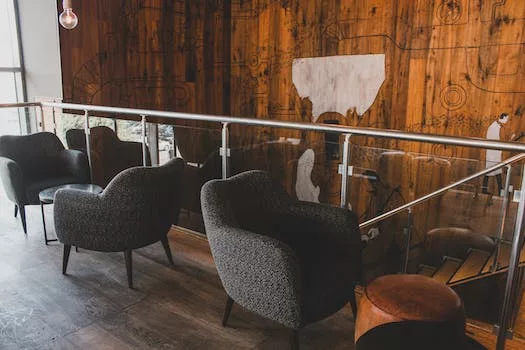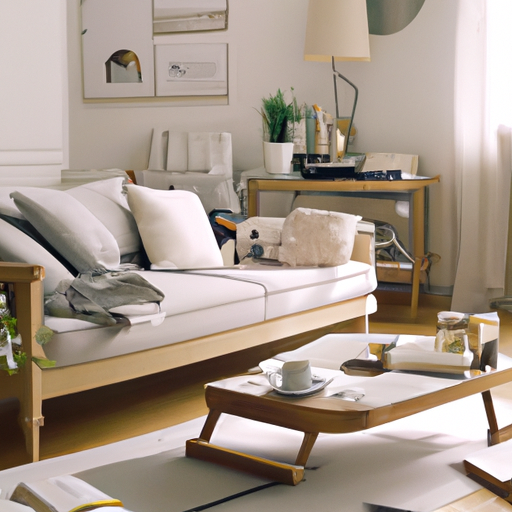Creating a Productive Home Office Space
In today’s fast-paced world, the concept of working from home has become increasingly popular. With advancements in technology and the rise of remote work, more and more people are opting to work from the comfort of their own homes. However, designing a home that is perfect for working from home can be a challenging task. It requires careful planning and consideration to create a space that is both functional and conducive to productivity. In this article, we will discuss some essential tips for designing a home that is perfect for working from home, focusing on creating a productive home office space.
First and foremost, it is crucial to designate a specific area in your home for your office space. This will help you maintain a clear boundary between your work and personal life, allowing you to focus on your tasks without any distractions. Ideally, this area should be separate from common living spaces, such as the living room or kitchen, to minimize interruptions and noise. If possible, choose a room with a door that can be closed to create a sense of privacy and seclusion.
Once you have identified the ideal location for your home office, it is essential to consider the layout and design of the space. A well-organized and clutter-free environment can significantly impact your productivity and overall work experience. Start by selecting a desk that is both functional and aesthetically pleasing. Ensure that it provides ample workspace and storage for your computer, documents, and other essential office supplies. Additionally, invest in a comfortable and ergonomic chair that supports proper posture and reduces the risk of developing back or neck pain.
Lighting is another critical aspect of designing a productive home office space. Natural light is known to boost mood, energy levels, and overall well-being, making it an essential component of any workspace. If possible, position your desk near a window to take advantage of natural light throughout the day. However, it is also important to have adequate artificial lighting for those cloudy days or late-night work sessions. Opt for adjustable task lighting that can be directed where needed, and consider using LED bulbs, which are energy-efficient and provide a more natural light quality.
In addition to lighting, the color scheme of your home office can also play a significant role in your productivity and focus. Studies have shown that certain colors can evoke specific emotions and psychological responses. For instance, blue is known to promote concentration and calmness, while green is associated with creativity and growth. Consider incorporating these colors into your home office design through paint, furniture, or decorative accents to create a space that fosters productivity and inspiration.
Another essential aspect of designing a home that is perfect for working from home is ensuring that your office space is equipped with the necessary technology and tools. This includes a reliable internet connection, a computer or laptop with sufficient processing power and storage, and any required software or applications. Additionally, consider investing in noise-canceling headphones or a high-quality speakerphone to facilitate clear communication during virtual meetings or conference calls.
Lastly, don’t forget to personalize your home office space. Adding personal touches, such as family photos, artwork, or plants, can make the space feel more inviting and comfortable. This, in turn, can help reduce stress and promote a positive work environment.
In conclusion, designing a home that is perfect for working from home requires careful planning and consideration of various factors, including location, layout, lighting, color scheme, and technology. By following these tips and creating a productive home office space, you can enjoy the benefits of working from home while maintaining a healthy work-life balance.
Balancing Comfort and Functionality in a Work-from-Home Environment

In recent years, the concept of working from home has gained significant traction, with more and more people opting for flexible work arrangements. The COVID-19 pandemic has further accelerated this trend, making remote work a necessity for many. As a result, designing a home that is conducive to both living and working has become increasingly important. Balancing comfort and functionality in a work-from-home environment is crucial to ensure productivity, focus, and overall well-being. In this article, we will explore some key considerations and tips for designing a home that is perfect for working from home.
First and foremost, it is essential to designate a specific area or room in your home as your workspace. This will help create a clear boundary between your work and personal life, allowing you to maintain a healthy work-life balance. Ideally, your workspace should be located in a quiet area of your home, away from distractions and noise. If possible, choose a room with a door that can be closed to minimize interruptions and maintain privacy during virtual meetings or phone calls.
Lighting plays a significant role in creating a comfortable and functional work environment. Natural light is known to boost mood, productivity, and overall well-being. Therefore, it is advisable to set up your workspace near a window that allows ample sunlight to stream in. If natural light is limited, invest in good-quality artificial lighting that mimics daylight. A combination of ambient, task, and accent lighting can help create a well-lit and visually appealing workspace.
Ergonomics is another crucial aspect to consider when designing a home that is perfect for working from home. Investing in ergonomic furniture, such as an adjustable chair and desk, can help prevent strain and discomfort during long hours of work. Ensure that your chair provides adequate lumbar support and that your desk is at an appropriate height to maintain proper posture. Additionally, consider incorporating accessories such as a footrest, wrist rest, or monitor riser to further enhance comfort and reduce the risk of injury.
Incorporating elements of biophilic design can also contribute to a more comfortable and functional work-from-home environment. Biophilic design is an approach that seeks to connect people with nature by incorporating natural elements into the built environment. This can be achieved by introducing indoor plants, using natural materials such as wood and stone, and incorporating nature-inspired patterns and textures in your home decor. Research has shown that biophilic design can improve productivity, reduce stress, and enhance overall well-being.
Finally, personalizing your workspace can help make it more comfortable and enjoyable to work in. Surround yourself with items that inspire and motivate you, such as artwork, photographs, or motivational quotes. However, be mindful not to clutter your workspace, as this can be distracting and hinder productivity. Maintain a clean and organized environment by incorporating storage solutions such as shelves, drawers, and filing cabinets to keep your work materials and documents in order.
In conclusion, designing a home that is perfect for working from home involves striking a balance between comfort and functionality. By considering factors such as designated workspaces, lighting, ergonomics, biophilic design, and personalization, you can create an environment that fosters productivity, focus, and well-being. As remote work continues to gain popularity, investing time and effort into creating a comfortable and functional work-from-home environment will undoubtedly pay off in the long run.
Integrating Work and Living Spaces for a Seamless Home Office Experience
In recent years, the concept of working from home has gained significant traction, with more and more people opting for flexible work arrangements. This shift in work culture has led to an increased demand for home designs that cater to the needs of remote workers. Designing a home that is perfect for working from home requires careful consideration of various factors, including the integration of work and living spaces for a seamless home office experience. This article will discuss some essential tips and ideas to help you create a functional and comfortable workspace within your home.
One of the most critical aspects of designing a home that is perfect for working from home is the allocation of dedicated workspace. This space should be separate from the rest of the living areas, allowing you to focus on your work without distractions. Ideally, the workspace should be located in a quiet part of the house, away from high-traffic areas such as the kitchen or living room. This separation will help you maintain a healthy work-life balance and prevent work-related stress from spilling over into your personal life.
When designing your workspace, it is essential to consider ergonomics. Invest in a comfortable chair that supports your back and promotes good posture. Ensure that your desk is at the right height, allowing you to work comfortably without straining your neck or shoulders. Additionally, make sure that your computer monitor is at eye level to prevent eye strain and headaches. Proper ergonomics will not only make your workspace more comfortable but also help you maintain good health and prevent work-related injuries.
Lighting is another crucial factor to consider when designing a home that is perfect for working from home. Natural light is the best option, as it helps to reduce eye strain and improve mood and productivity. If possible, position your workspace near a window to take advantage of natural light. However, if natural light is not an option, invest in good quality artificial lighting that mimics daylight. Avoid harsh overhead lights, as they can cause glare and eye strain. Instead, opt for task lighting, such as desk lamps, that can be adjusted to suit your needs.
Incorporating storage solutions into your workspace is essential for maintaining a clutter-free and organized environment. Clutter can be distracting and hinder productivity, so it is crucial to have a place for everything. Consider incorporating shelves, filing cabinets, or drawers into your workspace design to store documents, stationery, and other work-related items. Additionally, make use of vertical space by installing wall-mounted shelves or pegboards to keep your workspace organized and clutter-free.
Another essential aspect of designing a home that is perfect for working from home is creating a space that inspires creativity and productivity. Personalize your workspace with items that motivate and inspire you, such as artwork, photographs, or plants. Choose colors and patterns that you find calming and uplifting, as this can have a significant impact on your mood and productivity levels.
Finally, it is essential to consider the technological requirements of your work when designing your home office. Ensure that you have a reliable internet connection and invest in any necessary equipment, such as a computer, printer, or scanner. Additionally, consider incorporating cable management solutions into your workspace design to keep cords and cables organized and out of sight.
In conclusion, designing a home that is perfect for working from home requires careful consideration of various factors, including the integration of work and living spaces, ergonomics, lighting, storage solutions, and personalization. By taking these factors into account, you can create a functional, comfortable, and inspiring workspace that will help you maintain a healthy work-life balance and boost your productivity.
Q&A
Question 1: What are the essential elements to consider when designing a home that’s perfect for working from home?
Answer 1: The essential elements to consider when designing a home for working from home include a dedicated workspace, proper lighting, ergonomic furniture, noise control, and efficient storage solutions.
Question 2: How can one create an ergonomic and comfortable workspace for working from home?
Answer 2: To create an ergonomic and comfortable workspace, invest in an adjustable chair with lumbar support, a desk with appropriate height, a monitor at eye level, and a keyboard and mouse that promote neutral wrist positions. Additionally, ensure proper lighting to reduce eye strain and maintain a comfortable room temperature.
Question 3: How can one minimize distractions and maintain productivity while working from home?
Answer 3: To minimize distractions and maintain productivity, designate a specific area for work, separate from common living spaces. Implement noise control measures, such as soundproofing or using noise-cancelling headphones. Establish a routine, set boundaries with family members, and consider using productivity tools or techniques, such as the Pomodoro Technique.
Conclusion
In conclusion, designing a home that is perfect for working from home involves creating a dedicated workspace, ensuring proper ergonomics, incorporating natural light, minimizing distractions, and personalizing the space to enhance productivity and comfort. By considering these factors, one can create an efficient and enjoyable work environment within their home.


